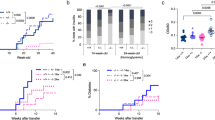Abstract
Pre-diabetic patients have a high risk of developing diabetes as well as other associated diseases. From the viewpoint of risk assessment and to assist the development of protective therapies, we focused on the functional role of natural killer T (NKT) cells in pre-diabetes. We found that the expression of an NKT cell marker gene, Va14-Ja18, was significantly lower in specific tissues/organs such as adipose tissue and pancreas in non-obese pre-diabetes model mice than in their normal littermates. Subsequently, in the pre-diabetes model mice, Va14-Ja18 was activated with α-galactosylceramide (α-GalCer) and its effect on glucose tolerance was estimated. The simultaneous injection of α-GalCer and lymphocytes improved glucose tolerance with its maximum effect on the 3rd day. An analysis of circulating cytokine levels revealed that interferon-γ, which is a pro-inflammatory cytokine, was secreted only on the 1st day after treatment with α-GalCer and that interleukin (IL)-4, which is an anti-inflammatory cytokine, was secreted from the 1st to the 4th day. The prolonged secretion of IL-4 was thought to substantially contribute to the improvement of glucose tolerance. Based on these results, the functional role of NKT cells in pre-diabetes is to improve metabolic dysfunctions.




Similar content being viewed by others
References
Bali D, Svetlanov A, Lee HW, DeMane DF, Leiser M, Li B, Barzilai N, Surana M, Hou H, Fleischer N, DePinko R, Rossetti L, Efrat S (1995) Animal model for maturity-onset diabetes of the young generated by disruptions of the mouse glucokinase gene. J Biol Chem 270:21464–21467
Bendelac A, Savage PB, Teyton L (2007) The biology of NKT cells. Annu Rev Immunol 25:297–336
Blumberg RS, Gerdes D, Chott A, Porcelli SA, Balk SP (1995) Structure and function of the CD1 family of MHC-like cell surface proteins. Immunol Rev 147:5–29
Brooks-Worrell B, Narla R, Palmer JP (2012) Biomarkers and immune-modulating therapies for type 2 diabetes. Trends Immunol 33:546–553
Hong S, Wilson MT, Serizawa I, Wu L, Singh N, Naidenko OV, Miura T, Haba T, Scherer DC, Wei J, Kronenberg M, Koezuka Y, Van Kaer L (2001) The natural killer T-cell ligand alpha-galactosylceramide prevents autoimmune diabetes in non-obese diabetic mice. Nat Med 7:1052–1056
Ji Y, Sun S, Xu A, Bhargava P, Yang L, Lam KSL, Gao B, Lee CH, Kersten S, Qi L (2012) Activation of natural killer T cells promotes M2 macrophage polarization in adipose tissue and improves systemic glucose tolerance via interleukin-4 (IL-4)/STAT6 protein signaling axis in obesity. J Biol Chem 287:13561–13571
Kawano T, Cui J, Koezuka Y, Toura I, Kaneko Y, Motoki K, Ueno H, Nakagawa R, Sato H, Kondo E, Koseki H, Taniguchi M (1997) CD1d-restricted and TCR-mediated activation of v_14 NKT cells by glycosylceramides. Science 278:1626–1629
Ohmura K, Ishimori N, Ohmura Y, Tokuhara S, Nozawa A, Horii S, Andoh Y, Fujii S, Iwabuchi K, Onoe K, Tsutsui H (2010) Natural killer T cells are involved in adipose tissues inflammation and glucose intolerance in diet-induced obese mice. Arterioscler Thromb Vasc Biol 30:193–199
Rydén L, Grant PJ, Anker SD, Berne C, Cosentino F, Danchin N, Deaton C, Escaned J, Hammes H-P, Huikuri H, Marre M, Marx N, Mellbin L, Ostergren J, Patrono C, Seferovic P, Uva MS, Taskinen M-R, Tendera M, Tuomilehto J, Valensi P, Zamorano JL (2014) ESC Guidelines on diabetes, pre-diabetes, and cardiovascular diseases developed in collaboration with the European Association for the study of diabetes. Diabetes Vasc Dis Res 11:133–173
Saito M, Kaneda A, Sugiyama T, Iida R, Otokuni K, Kaburagi M, Matsuoka H (2015) Production of a mouse strain with impaired glucose tolerance by systemic heterozygous knockout of glucokinase gene and its feasibility as a pre-diabetes model. Exp Anim 64:231–239
Saito M, Kaneda A, Shigeto H, Hanata N, Otokuni K, Matsuoka H (2016) Development of an optimized 5-stage protocol for the in vitro preparation of insulin-secreting cells from mouse ES cells. Cytotechnology 68:987–998
Satoh M, Hoshino M, Fujita K, Iizuka M, Fujii S, Clingan CS, Kaer LV, Iwabuchi K (2016) Adipocyte-specific CD1d-deficiency mitigates diet-induced obesity and insulin resistance in mice. Sci Rep 6:28473
Schipper HS, Rakhshandehroo M, van de Graaf SFJ, Venken K, Koppen A, Stienstra R, Prop S, Meerding J, Hamers N, Besra G, Boon L, Nieuwenhuis EES, Elewaut D, Prakken B, Kersten S, Boes M, Kalkhoven E (2012) Natural killer T cells in adipose tissue prevent insulin resistance. J Clin Investig 122:3343–3354
Seino Y, Nanjo K, Tajima N, Kadowaki T, Kashiwagi A, Araki E, Ito C, Inagaki N, Iwamoto Y, Kasuga M, Hanafusa T, Haneda M, Ueki K (2010) Report of the committee on the classification and diagnostic criteria of diabetes mellitus. J Diabetes Investig 1:212–228
Takatsu K, Urakaze M, Kobayashi M, Tobe K (2009) Regulatory mechanisms for adipose tissue M1 and M2 macrophages in diet-induced obese mice. Diabetes 58:2574–2582
Wentworth JM, Naselli G, Brown WA, Doyle L, Phipson B, Smyth GK, Wabitsch M, O’Brien PE, Harrison LC (2010) Pro-inflammatory CD11c+CD206+ adipose tissue macrophages are associated with insulin resistance in human obesity. Diabetes 59:1648–1656
Acknowledgements
This work was supported in part by the Strategic Research Promotion Program of the Ministry of Education, Culture, Sports, Science, and Technology, on the research subject “Development of Next Generation Bioresources”. We appreciate the valuable advice about experimental methodology that we received from Prof. Emer. Hideaki Matsuoka of Tokyo University of Agriculture and Technology. We also thank Kana Kitazumi and Eri Ochiai for their technical support.
Author information
Authors and Affiliations
Corresponding author
Electronic supplementary material
Below is the link to the electronic supplementary material.
Rights and permissions
About this article
Cite this article
Saito, M., Kaburagi, M., Otokuni, K. et al. Functional role of natural killer T cells in non-obese pre-diabetes model mice. Cytotechnology 70, 423–430 (2018). https://doi.org/10.1007/s10616-017-0157-5
Received:
Accepted:
Published:
Issue Date:
DOI: https://doi.org/10.1007/s10616-017-0157-5




